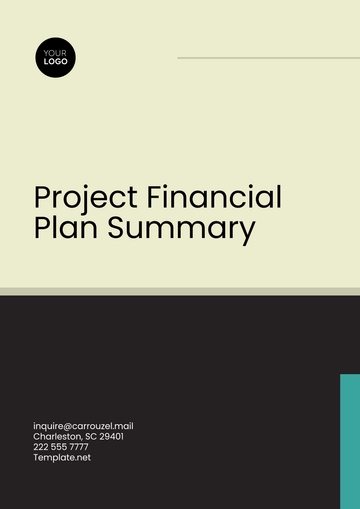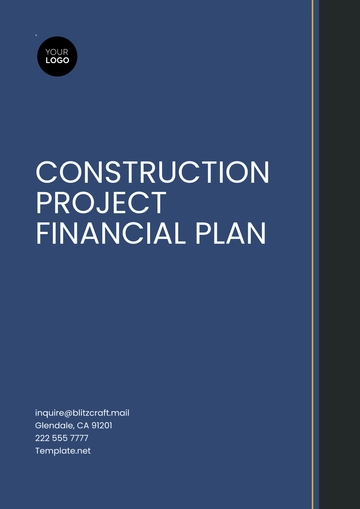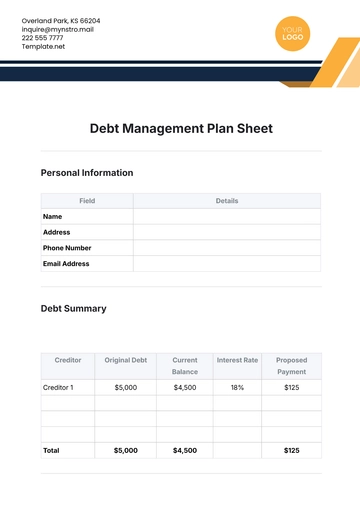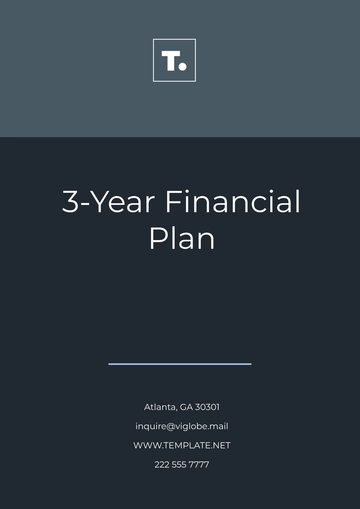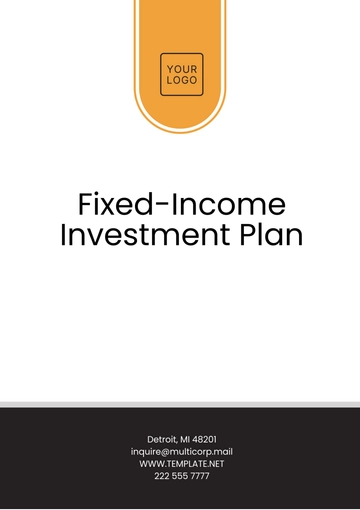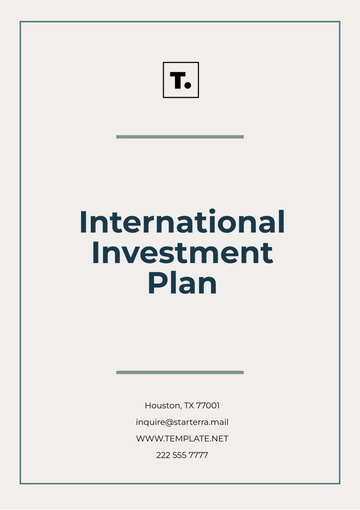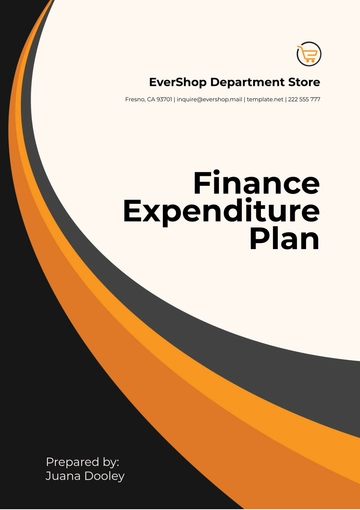Free Detailed Financial Plan
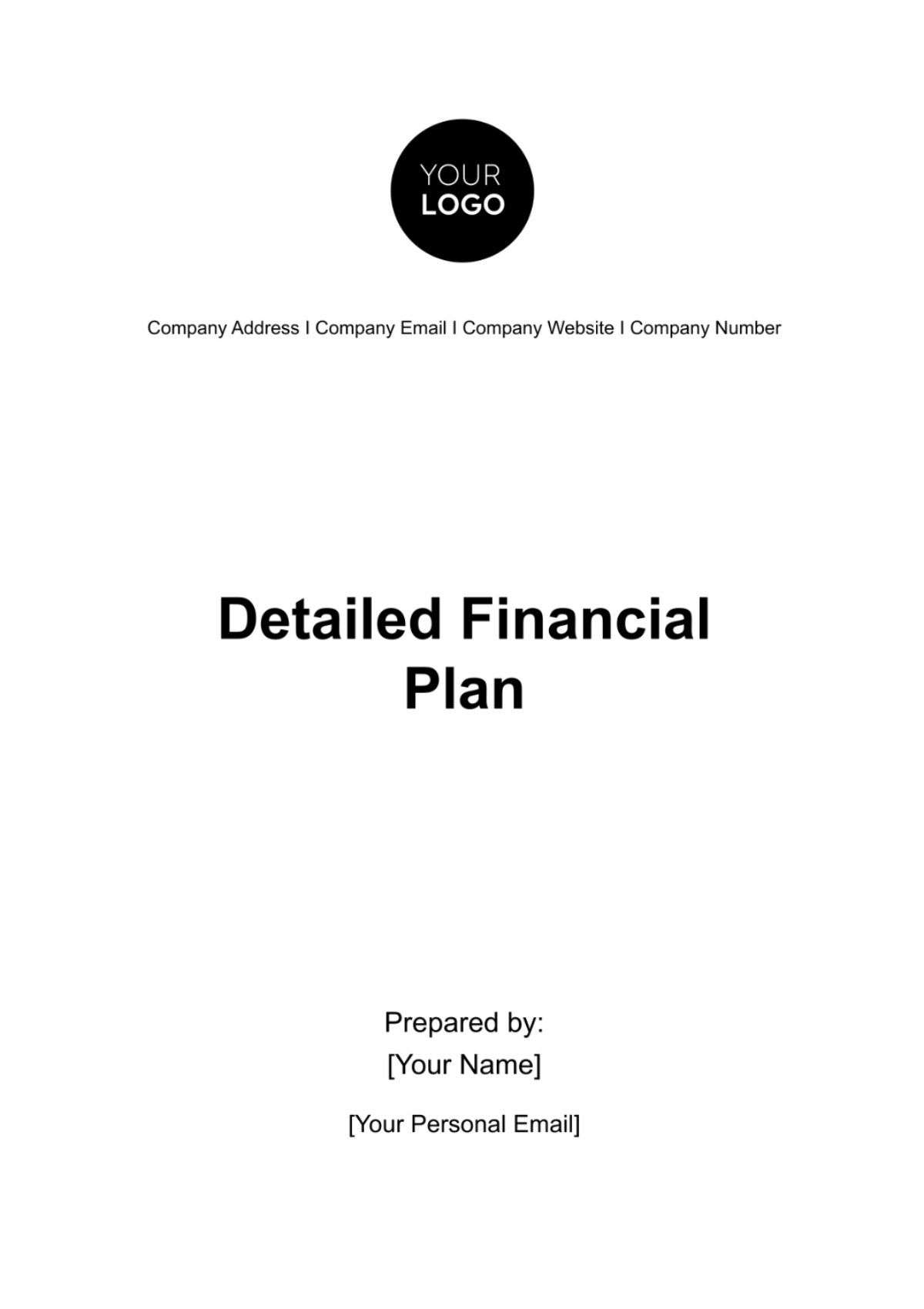
Executive Summary
Our Detailed Financial Plan represents a comprehensive and strategic approach to achieving our financial goals, ensuring financial security, and safeguarding our wealth for the future. This plan encompasses various facets of financial management, including current financial assessment, goal setting, budgeting, investment, debt management, risk mitigation, tax planning, retirement, estate planning, and ongoing performance monitoring. It reflects our commitment to responsible financial stewardship and prudent wealth management.
This plan serves as a roadmap to guide our financial decisions, enabling us to achieve our goals and adapt to changing circumstances. By adhering to this plan and remaining vigilant in our financial management, we are confident in our ability to secure a financially sound future.
Current Financial Assessment
In this section, we provide a detailed assessment of our current financial status, a crucial step in shaping our overall financial plan. This assessment offers a clear picture of our assets, liabilities, income, and expenses, as well as an evaluation of our credit standing and existing debt obligations.
Credit Assessment and Current Debt Obligations
Our current credit rating stands at 'AA', indicating a high level of creditworthiness and financial stability. This favorable rating is a result of our consistent on-time payments, low credit utilization ratio, and a strong history of prudent financial management.
Regarding our current debt obligations, we have a short-term debt of $200,000, primarily comprising a line of credit and short-term loans, which are managed effectively to support our working capital requirements. Our long-term debt amounts to $600,000, which includes a mortgage on corporate property and a business loan. These debts are structured with favorable interest rates and terms, reflecting our strong negotiation capabilities and credit standing. The consistent servicing of these debts has positively contributed to our robust credit rating.
Category | Description | Amount (in $) |
Assets | ||
Cash and Cash Equivalents | Immediate liquidity available. | 500,000 |
Investments | Stocks, bonds, and other securities. | 1,200,000 |
Property and Equipment | Value of owned physical assets. | 800,000 |
Inventory | Goods available for sale. | 300,000 |
Total Assets | 2,800,000 | |
Liabilities | ||
Short-term Debt | Loans and obligations due within a year. | 200,000 |
Long-term Debt | Loans and obligations due beyond a year. | 600,000 |
Accounts Payable | Money owed to suppliers. | 150,000 |
Total Liabilities | 950,000 | |
Income | ||
Annual Revenue | Total income from sales and services. | 2,000,000 |
Other Income | Additional income sources. | 100,000 |
Total Income | 2,100,000 | |
Expenses | ||
Operating Expenses | Day-to-day running costs. | 1,000,000 |
Payroll | Total staff salaries and wages. | 700,000 |
Miscellaneous | Other various expenses. | 100,000 |
Total Expenses | 1,800,000 |
Financial Goals
In this section, we outline our financial goals, which are structured into short-term, medium-term, and long-term categories. Setting clear and measurable financial objectives is essential to charting our course for financial success and ensuring that our financial plan aligns with our organizational aspirations.
Short-Term Financial Goals (1-2 Years)
Increase Liquidity: Build cash reserves to a minimum of $750,000 within the next year to enhance our short-term financial stability and flexibility.
Reduce Short-Term Debt: Reduce our short-term debt by 20% within the next two years, focusing on paying down high-interest loans to optimize our debt structure.
Medium-Term Financial Goals (3-5 Years)
Sustainable Revenue Growth: Achieve an annual revenue growth rate of at least 8% over the next five years through a combination of new product launches and expanding our customer base.
Optimize Cost Management: Improve cost management practices, targeting a 10% reduction in operating expenses over the next three years through process efficiencies and resource optimization.
Enhance Investment Portfolio: Diversify and enhance our investment portfolio to achieve an average annual return of 6% over the medium term, supporting our long-term financial objectives.
Long-Term Financial Goals (5+ Years)
Retirement Fund: Accumulate a retirement fund of $2,500,000 within the next 15 years, ensuring financial security for our leadership team and employees.
Debt-Free Status: Work towards becoming debt-free over the next decade by steadily reducing and restructuring our long-term debt obligations.
Sustainable Growth: Achieve consistent and sustainable growth in annual revenue, aiming to double our current revenue figures over the next decade through strategic expansion and market penetration.
Budget Creation and Management
This section focuses on our budget creation and management strategies, a cornerstone of our financial plan. We believe that a well-structured budget, combined with effective management and adherence strategies, is essential for achieving our financial goals and maintaining financial stability.
Comprehensive Budget
We have prepared a comprehensive budget that outlines our expected revenues, expenses, and investments for the upcoming fiscal year. The budget is designed to align with our short-term financial goals and provides a detailed breakdown of financial categories.
Category | Description | Amount (in $) |
Revenue | ||
Sales Revenue | Projected income from sales. | $2,200,000 |
Other Income | Additional income sources. | $100,000 |
Total Revenue | $2,300,000 | |
Expenses | ||
Operating Expenses | Day-to-day operational costs. | $1,000,000 |
Payroll | Staff salaries and wages. | $700,000 |
Marketing and Promotion | Marketing and advertising expenses. | $150,000 |
Research and Development | Investment in product development. | $100,000 |
Miscellaneous Expenses | Other various expenses. | $50,000 |
Total Expenses | $2,000,000 | |
Net Income | $300,000 |
Strategies for Budget Management and Adherence
We will implement a system for regular budget monitoring, tracking actual financial performance against budgeted figures on a monthly basis. Any significant variances between actual and budgeted expenses or revenues will be promptly analyzed, and corrective actions will be taken as needed. To optimize cost management, we will actively seek opportunities to reduce operating expenses without compromising the quality of our products and services.
Savings and Investment Plan
In this section, we outline our Savings and Investment Plan, which is fundamental to achieving our medium and long-term financial goals. We begin by assessing our risk tolerance and defining our investment goals, followed by strategies and investment options tailored to our financial objectives and risk profile.
Risk Tolerance and Investment Goals
Risk Profile | Risk Tolerance | Investment Goals |
Conservative | Low risk tolerance | Capital preservation and steady income. |
Moderate | Moderate risk tolerance | Balanced growth and income generation. |
Aggressive | High risk tolerance | Capital appreciation and long-term growth. |
Savings Strategies and Investment Options
Conservative Portfolio (Low Risk Tolerance)
Savings Strategy: Allocate a significant portion of funds to high-yield savings accounts and short-term government bonds to prioritize capital preservation.
Investment Options: Consider low-risk investments such as Treasury bonds, certificates of deposit (CDs), and dividend-paying stocks.
Moderate Portfolio (Moderate Risk Tolerance)
Savings Strategy: Maintain a mix of savings and moderate-term investments to achieve a balance between capital preservation and growth.
Investment Options: Invest in a diversified portfolio of stocks and bonds, including index funds and ETFs, with a focus on dividend growth.
Aggressive Portfolio (High Risk Tolerance)
Savings Strategy: Allocate a smaller portion to savings accounts and emphasize long-term investment opportunities with potential for higher returns.
Investment Options: Explore growth-oriented investments, including individual stocks, growth-oriented mutual funds, and alternative investments such as real estate investment trusts (REITs).
Debt Management Strategy
In this section, we outline our Debt Management Strategy, which encompasses both our approach to paying off current debts and our strategies for avoiding or prudently managing future debt. Effective debt management is vital to maintaining financial stability and achieving our financial goals.
Paying off Current Debts
Our current debt obligations include both short-term and long-term debts, as outlined in the Current Financial Assessment section. To manage these obligations effectively, we have developed the following plan:
Debt Prioritization: We prioritize the repayment of high-interest, short-term debts to reduce interest expenses and improve cash flow.
Regular Debt Servicing: We commit to making on-time and consistent debt payments, adhering to the terms and schedules outlined in our loan agreements.
Debt Restructuring: Where possible, we explore opportunities to refinance or restructure existing debts to secure more favorable terms, such as lower interest rates or extended repayment periods.
Strategies for Avoiding or Managing Future Debt
To ensure that we maintain a healthy balance between debt and financial stability, we have established the following strategies:
Strategic Financing: We adopt a prudent approach to financing major capital expenditures and investments, considering alternatives such as equity financing and retained earnings before resorting to debt.
Cash Flow Management: We implement robust cash flow management practices to ensure that our operational cash flows are sufficient to cover day-to-day expenses and minimize the need for short-term borrowing.
Debt Capacity Analysis: Before taking on new debt, we conduct a thorough analysis of our debt capacity, considering our existing debt load, projected cash flows, and risk tolerance.
Credit Monitoring: We regularly monitor our credit standing and maintain open communication with creditors to negotiate favorable terms and conditions when necessary.
Risk Management and Insurance
In this section, we address our approach to risk management and the role of insurance in mitigating potential financial risks. A thorough analysis of potential risks, including their likelihood and impact, guides our decisions on appropriate insurance coverage.
Risk Category | Likelihood | Impact | Insurance Coverage |
Business Interruption | Medium | High | Business Interruption Insurance, Contingent Business Interruption Insurance |
Supply Chain Disruption | Medium | Medium | Supply Chain Insurance |
Market Volatility | Medium | High | Hedging Instruments, Portfolio Diversification |
Credit Risk | Medium | High | Credit Insurance, Credit Risk Analysis |
Regulatory Changes | Medium | Medium | Legal Consultation, Compliance Insurance |
Litigation | Low | High | Liability Insurance, Legal Defense Fund |
Natural Disasters | Low | High | Property Insurance, Disaster Recovery Plan |
Environmental Liability | Medium | Medium | Environmental Liability Insurance |
Tax Planning
In this section, we delve into our Tax Planning strategies aimed at minimizing tax liabilities while ensuring compliance with relevant tax laws and regulations. Effective tax planning plays a pivotal role in optimizing our financial position and maximizing after-tax returns.
Strategies to Minimize Tax Liabilities
Tax-Efficient Investments: We prioritize tax-efficient investment vehicles, such as tax-deferred retirement accounts (e.g., 401(k)) and tax-free municipal bonds, to minimize tax liability on investment income.
Income Splitting: We explore income splitting strategies among family members to take advantage of lower tax brackets, effectively reducing our overall tax burden.
Expense Deductions: We diligently track and maximize expense deductions, including business expenses, charitable contributions, and eligible tax credits, to reduce taxable income.
Capital Gains Management: We implement tax-efficient capital gains management strategies, such as holding assets for the long term to qualify for lower capital gains tax rates.
Tax Credits and Incentives: We identify and leverage available tax credits and incentives for our industry, region, and business activities to reduce our overall tax liability.
Retirement Planning: We incorporate tax-efficient retirement planning by contributing to tax-advantaged retirement accounts and exploring Roth conversion strategies.
Estate Planning: Our estate planning includes tax-efficient wealth transfer strategies to minimize estate and inheritance taxes, preserving family wealth for future generations.
Regular Tax Reviews: We conduct regular reviews of our tax positions, ensuring that our strategies remain aligned with changing tax laws and regulations.
Retirement Planning
In this section, we delve into our Retirement Planning strategies, a critical aspect of our long-term financial plan. We assess our retirement goals, the required savings, and outline strategies for retirement fund accumulation and management.
Assessment of Retirement Goals and Required Savings
Retirement Goal | Target Age | Desired Retirement Income (per year) | Required Retirement Savings |
Early Retirement (Option 1) | 55 | $60,000 | $1,500,000 |
Standard Retirement (Option 2) | 65 | $80,000 | $2,000,000 |
Secure Retirement (Option 3) | 70 | $100,000 | $2,500,000 |
Strategies for Retirement Fund Accumulation and Management
Regular Contributions: We commit to making regular contributions to retirement accounts, such as 401(k) plans, IRAs, and Roth IRAs, to ensure steady fund accumulation.
Diversified Investments: Our retirement portfolio includes a diversified mix of assets, including stocks, bonds, and low-risk investments, to balance growth potential with risk mitigation.
Tax-Efficient Investments: We prioritize tax-advantaged retirement accounts to maximize tax benefits and optimize retirement fund growth.
Employer Matching: We take full advantage of employer-sponsored retirement plans that offer matching contributions, effectively doubling our retirement savings.
Adjustable Risk Tolerance: As we approach retirement age, we gradually adjust our portfolio's risk tolerance to protect accumulated assets while ensuring growth opportunities.
Estate Planning
In this section, we address our Estate Planning strategies, which are integral to the preservation and efficient transfer of our assets to heirs and beneficiaries. Estate planning is not only about wealth distribution but also about ensuring the orderly transition of assets while minimizing tax liabilities.
Development of an Estate Plan
Our estate plan encompasses various elements to ensure the seamless transfer of assets in accordance with our wishes. Key components include:
Component | Implementation |
Last Will and Testament | Involves consulting with an attorney to draft a will that reflects our wishes, naming beneficiaries, and designating an executor responsible for executing the will's instructions. Regular updates are made to ensure accuracy. |
Revocable Living Trust | Includes creating a trust document, transferring assets into the trust, and appointing a trustee to manage trust assets. This helps streamline the transfer of assets to beneficiaries without going through probate court. |
Durable Power of Attorney | Involves legally designating an attorney-in-fact to act on our behalf, making financial and legal decisions when we are unable to do so. The designated individual is informed of their responsibilities and given access to necessary documents. |
Healthcare Proxy | Includes selecting a healthcare proxy, discussing our medical preferences and values with them, and providing them with access to our medical records and documents. |
Guardianship Designation | Involves legally designating guardians in our will, clearly outlining our expectations for the care and upbringing of our dependents. |
Beneficiary Designations | Entails regularly reviewing and updating beneficiary designations on retirement accounts, life insurance policies, and financial accounts to ensure they reflect our current wishes and circumstances. |
Performance Review and Adjustment Plan
In this section, we outline our Performance Review and Adjustment Plan, which is crucial for maintaining the relevance and effectiveness of our financial plan. Regular reviews and adjustments ensure that our plan remains aligned with our goals, accommodating changes in our financial circumstances and life events.
Regular Review Schedule for the Financial Plan
To maintain the health and relevance of our financial plan, we have established a regular review schedule:
Frequency | Review Elements |
Annual | Investment portfolio performance, budget adherence, retirement savings progress, and insurance coverage. |
Bi-Annual | Debt management progress, tax planning strategies, and estate planning updates. |
As Needed | Adjustment of strategies in response to significant life events, market fluctuations, or regulatory changes. |
Strategies for Adjusting the Plan
Budget Adjustments: We revisit our budget regularly to ensure that it aligns with our financial goals and evolving needs. Adjustments are made to accommodate changes in income, expenses, or financial objectives.
Investment Portfolio Rebalancing: We rebalance our investment portfolio as needed to maintain the desired asset allocation, ensuring that our risk tolerance and goals are in harmony.
Debt Management Flexibility: Our debt management strategy is adaptable to changing financial circumstances, allowing for adjustments to payment schedules or refinancing when beneficial.
Tax Planning Optimization: We continuously monitor changes in tax laws and regulations, adjusting our tax planning strategies to optimize tax efficiency.
- 100% Customizable, free editor
- Access 1 Million+ Templates, photo’s & graphics
- Download or share as a template
- Click and replace photos, graphics, text, backgrounds
- Resize, crop, AI write & more
- Access advanced editor
The Detailed Financial Plan Template from Template.net is an essential tool for creating in-depth financial strategies. Fully editable and customizable in our AI Editor tool, this template allows for detailed planning and analysis of financial goals and methods. It's ideal for individuals and businesses seeking to develop a comprehensive roadmap for financial success and stability.
You may also like
- Finance Plan
- Construction Plan
- Sales Plan
- Development Plan
- Career Plan
- Budget Plan
- HR Plan
- Education Plan
- Transition Plan
- Work Plan
- Training Plan
- Communication Plan
- Operation Plan
- Health And Safety Plan
- Strategy Plan
- Professional Development Plan
- Advertising Plan
- Risk Management Plan
- Restaurant Plan
- School Plan
- Nursing Home Patient Care Plan
- Nursing Care Plan
- Plan Event
- Startup Plan
- Social Media Plan
- Staffing Plan
- Annual Plan
- Content Plan
- Payment Plan
- Implementation Plan
- Hotel Plan
- Workout Plan
- Accounting Plan
- Campaign Plan
- Essay Plan
- 30 60 90 Day Plan
- Research Plan
- Recruitment Plan
- 90 Day Plan
- Quarterly Plan
- Emergency Plan
- 5 Year Plan
- Gym Plan
- Personal Plan
- IT and Software Plan
- Treatment Plan
- Real Estate Plan
- Law Firm Plan
- Healthcare Plan
- Improvement Plan
- Media Plan
- 5 Year Business Plan
- Learning Plan
- Marketing Campaign Plan
- Travel Agency Plan
- Cleaning Services Plan
- Interior Design Plan
- Performance Plan
- PR Plan
- Birth Plan
- Life Plan
- SEO Plan
- Disaster Recovery Plan
- Continuity Plan
- Launch Plan
- Legal Plan
- Behavior Plan
- Performance Improvement Plan
- Salon Plan
- Security Plan
- Security Management Plan
- Employee Development Plan
- Quality Plan
- Service Improvement Plan
- Growth Plan
- Incident Response Plan
- Basketball Plan
- Emergency Action Plan
- Product Launch Plan
- Spa Plan
- Employee Training Plan
- Data Analysis Plan
- Employee Action Plan
- Territory Plan
- Audit Plan
- Classroom Plan
- Activity Plan
- Parenting Plan
- Care Plan
- Project Execution Plan
- Exercise Plan
- Internship Plan
- Software Development Plan
- Continuous Improvement Plan
- Leave Plan
- 90 Day Sales Plan
- Advertising Agency Plan
- Employee Transition Plan
- Smart Action Plan
- Workplace Safety Plan
- Behavior Change Plan
- Contingency Plan
- Continuity of Operations Plan
- Health Plan
- Quality Control Plan
- Self Plan
- Sports Development Plan
- Change Management Plan
- Ecommerce Plan
- Personal Financial Plan
- Process Improvement Plan
- 30-60-90 Day Sales Plan
- Crisis Management Plan
- Engagement Plan
- Execution Plan
- Pandemic Plan
- Quality Assurance Plan
- Service Continuity Plan
- Agile Project Plan
- Fundraising Plan
- Job Transition Plan
- Asset Maintenance Plan
- Maintenance Plan
- Software Test Plan
- Staff Training and Development Plan
- 3 Year Plan
- Brand Activation Plan
- Release Plan
- Resource Plan
- Risk Mitigation Plan
- Teacher Plan
- 30 60 90 Day Plan for New Manager
- Food Safety Plan
- Food Truck Plan
- Hiring Plan
- Quality Management Plan
- Wellness Plan
- Behavior Intervention Plan
- Bonus Plan
- Investment Plan
- Maternity Leave Plan
- Pandemic Response Plan
- Succession Planning
- Coaching Plan
- Configuration Management Plan
- Remote Work Plan
- Self Care Plan
- Teaching Plan
- 100-Day Plan
- HACCP Plan
- Student Plan
- Sustainability Plan
- 30 60 90 Day Plan for Interview
- Access Plan
- Site Specific Safety Plan

